1967 German Grand Prix race report: Brabham shows its steel
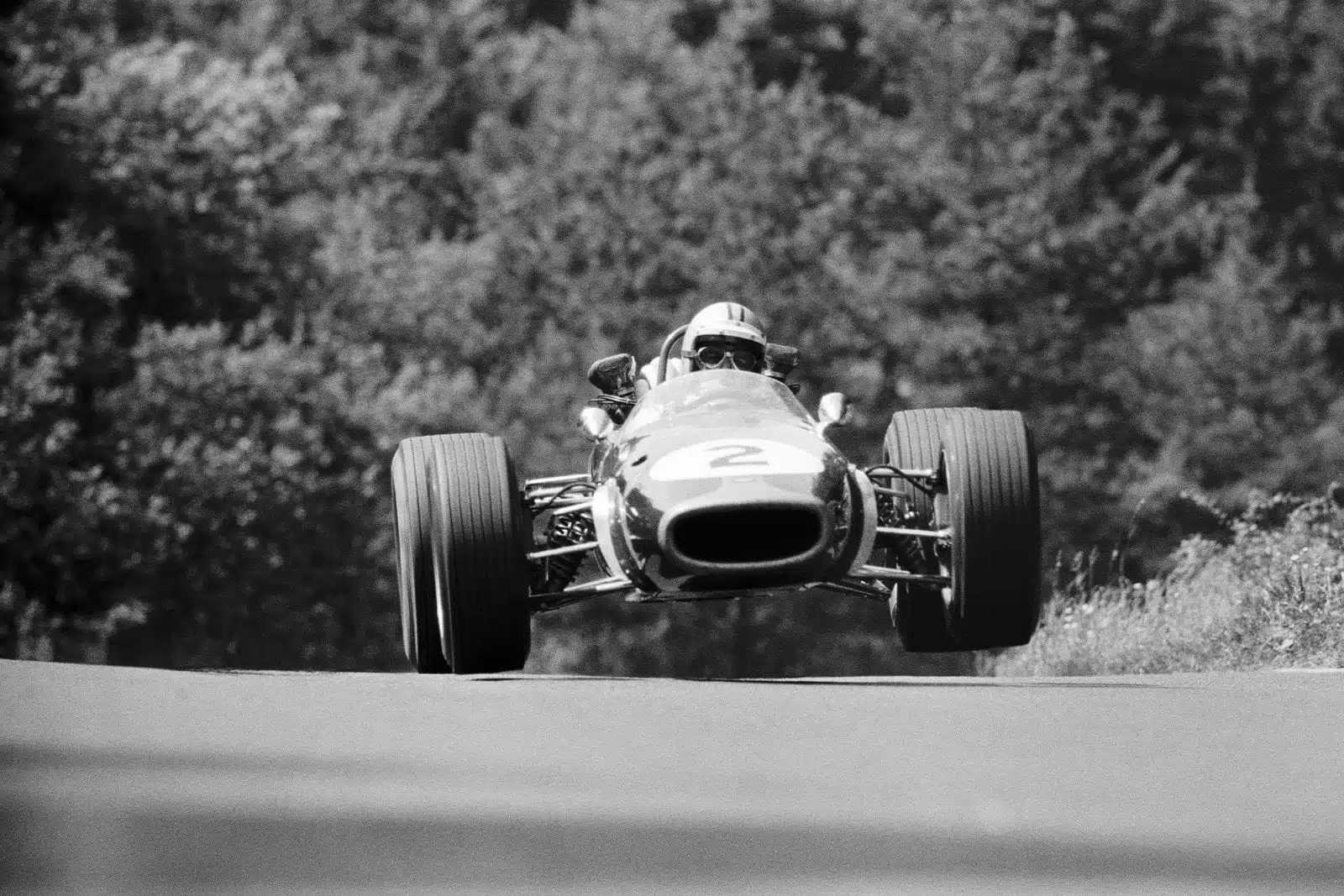
Denny Hulme's Brabham catches some air on his way to victory
Motorsport Images
During the three weeks since the last Grand Prix most of the teams had been very busy, either stocking up with cars and engines, or carrying out test programmes at Goodwood, Silverstone, Zandvoort or the Nürburgring itself, and most teams arrived in good time for the first practice, on Friday morning. Brabham and Hulme had the two 1967 cars, BT24-1 and BT24-2, while Brabham also had his old 1965 car as a stand-by.
Team Lotus also had three cars. Clark with 49/2 that he has been driving since Zandvoort, and Hill with 49/1, the car that crashed in practice at Silverstone, it now being all straightened out and new.
Knowing the ravages that the Nürburgring can inflict on a team the Lotus boys had 49/3 as a stand-by. Since the large Allen screw on the rear suspension on Hill’s car came undone (or was not done up properly) at Silverstone, as illustrated in last Month’s Motor Sport, these vital bolts have been replaced by a fixed stud with a self-locking nut holding the top link in place, there being a lock-nut on the stud itself and this is now wired for safety.
Another change was the removal of all the ignition accessories, and their mounting plate, from the top of the gearbox to a new position in the vee of the engine, between the rear four air intakes.
Cooper had their new very low and flat car, with the new 36-valve Maserati engine and Hewland gearbox, for Rindt to drive, the first one of the 1967 cars as a spare and Rodriguez retained his 1966 car, though it was now fitted with a Hewland gearbox in place of the ZF gearbox, so that all the works Coopers now use the latest Hewland gearbox.
Surtees had the earlier of his two Hondas, with the latest improved engine, the only noticeable outward change being a new and less complicated exhaust system.
Amon had two Ferraris to choose from, the latest and lighter car, 0005, which was fitted with a new gearbox and the latest version of the proven V12-cylinder engine. While not giving any more power than previously the new engine is lighter and the new gearbox follows the pattern of that fitted to the Formula Two car, with the selector rod on top of the box and running forwards through the vee of the engine to a rocking lever behind the driving seat, this lever being controlled by a right-hand lever in the cockpit. The spare car was 0003, unchanged from previous races, using the earlier type gearbox, with the selector rod running along the right side and through the chassis sponson.
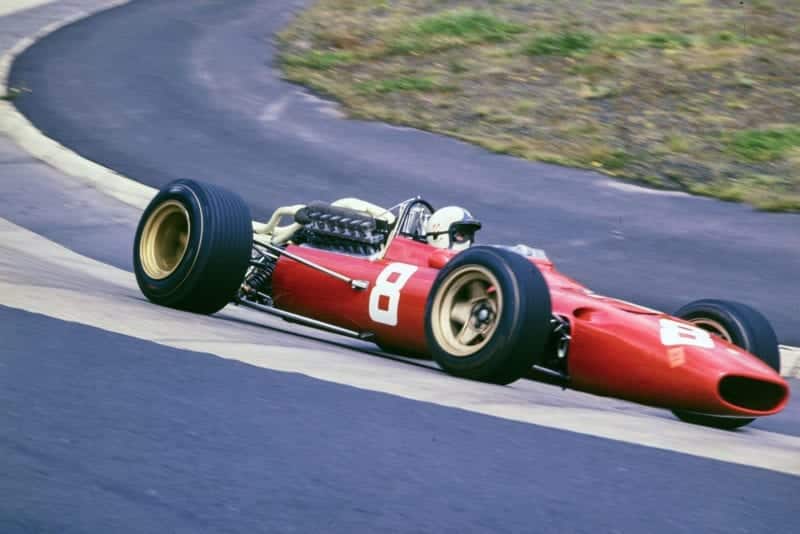
Amon was the sole Ferrari entry
Motorsport Images
Gurney and McLaren had the Eagle-Weslake V12 cars, number 104 for the former and 102 for the latter, the engine in 104 being a new one but fitted with the earlier type of fuel injection, where the injector nozzles are above the throttle slides. This system gives a better spread of power, at the expense of a little loss at the top end, compared with the system used on 102 where the injectors are below the throttle slides and squirt upwards.
The BRM team were asked by the AvD, who organise the race, to bring 3-litre cars or not bother to come, so they turned out in force with four H16-cylinder cars. Stewart had the latest car, 1151, lighter and slimmer than the others, with an earlier car 8302 as a spare.
Spence had an earlier car, 8303, as did Irwin, 8302, the last being entered by Tim Parnell. The Rob Walker Cooper-Maserati had had its engine rebuilt as best as possible in view of the lack of new parts at Maserati and Siffert was to drive it as usual. Bonnier was there with his Cooper-Maserati and Ligier’s money obviously suited Brabham as the Frenchman had the ex-works car he raced at Silverstone, now painted blue.
To give a bit of national encouragement the BMW factory were allowed to run one of their Formula Two Lola chassis fitted with a 2-litre 16-valve engine and driven by Hahne.
In view of the length of the Nürburgring the AvD invited a handful of Formula Two cars and drivers to take part in a separate race, run concurrently with the Grand Prix. This entry comprised eight cars with 16-valve Cosworth FVA engines and one with BMW engine, the eight being two Brabhams, Mitter’s own car and Rees in a Winkelmann car, two Matras, Schlesser with his Ford-France car and Ickx with a Tyrrell car, two Protoi cars, Ahrens and Hart driving, a single Lola entered by David Bridges for Redman to drive, a single works Lotus 48 for Oliver, entered by Lotus Components, and the remaining car was the Team Surtees works Lola with BMW engine, which Hobbs was to drive.
Drivers who had been to the ADAC 1,000-kilometre race earlier in the year know about the new bends introduced into the Tiergarten section of the circuit, on the approach to the Start and Finish area, in order to reduce the speed of the cars through the pit area.
In view of the effect these bends are referred to now as the Bremscurve and ten seconds additional time is generally accepted as the handicap, so that with fastest time last year standing to Clark in practice, with 8min 16.5sec, it was felt that 8min 25sec would be a good bogey time, until it was recalled that he had recorded this time in an old 2-litre Climax V8 engine car and there has been a lot of technical progress since then.
Qualifying

Hill spent so long adjusting his car that he didn’t complete a full lap on the first day of qualifying
Motorsport Images
Practice started on Friday morning and there was a depressing air of unreadiness and it seemed as if everyone was going to be content to go round and round the short “pits circuit” which comprises the pit straight, the South Curve, the straight behind the pits, through a gate in the fence and down the pits straight again. This “short” circuit is useful for it means that a driver can make sure that his car is running properly before setting off for a lap on the full circuit and in addition it means that he does not have to do a whole lap before passing the time-keepers, which would be the case if he went straight off from the pits and round the full circuit.
McLaren was delayed in the paddock as his fuel-injection metering unit was not working properly, and Graham Hill was busy adjusting his Lotus to his liking and “sticking pieces of bungy all over the place” to quote Chapman; in consequence neither driver put in a full lap.
“Times were dreadfully slow and no-one seemed very well prepared”
The others eventually set off on the full circuit, but times were dreadfully slow and no-one seemed very well prepared, even the Honda which had been at the circuit all week. Some idea of how unprepared the Grand Prix teams seemed to be was indicated by Ickx doing 8min 27.5sec, which was the fastest time for a long while, and this in a Formula Two car.
Eventually some semblance of order began to appear and Hulme did 8min 25.4sec and Surtees improved on this with 8min 25.0sec, but none of the practice was very inspiring and a lot of drivers were finding their cars air-borne for longer than was comfortable, either because the suspension adjustments were wrong, the cars were going faster than last year, or they had just forgotten that the Nürburgring is not a flat aerodrome circuit!
The Lotus 49 of Clark was having an unusual trouble for the brakes did not feel right and the trouble was traced to them being too efficient. Because of the excellent cooling afforded by the ventilated discs and the fact that the discs were out in the air-stream, they were not reaching the best working temperature and the pads were glazing the discs. During the lunch break Clark’s car was fitted with thin solid brake discs in place of the thick ventilated ones, and harder pads were used, while Hill’s car kept the ventilated discs and used softer pad material.
During the afternoon practice lap times improved considerably as teams became more organised, but once again Ickx had everyone on their toes for he did 8min 14.0sec in the little Matra Formula Two car and this stayed as fastest lap for a long while.
The Lotus comparative brake tests came to naught as Hill’s car only did half a lap before the gearbox seized up through lack of oil and 49/3 had to be brought up from the paddock and got ready for him to try again.
Clark was improving his lap times, but the car was far from right and it was left to Hulme to do something about the cheeky young Ickx and his Formula Two car, but even so Hulme only improved on the Matra time by half a second.
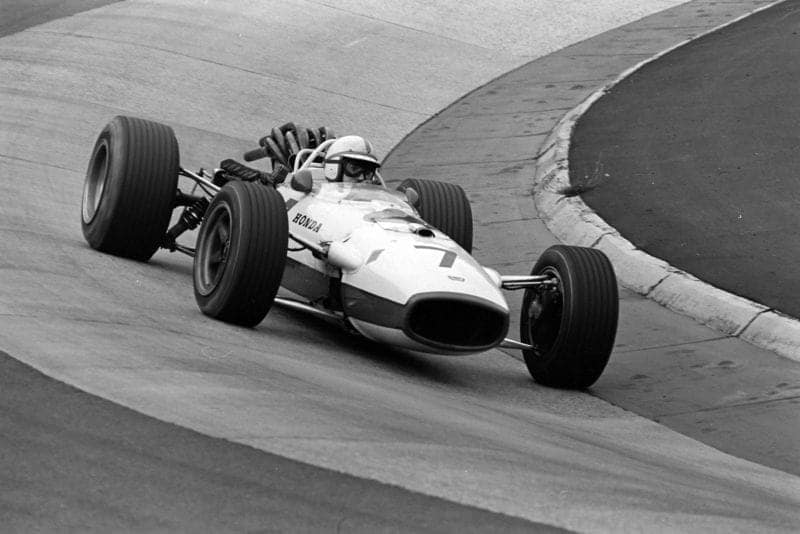
Surtees’ Honda was one of a number of cars to suffer reliability issues during qualifying
Motorsport Images
Spence was in trouble with a broken gearbox shaft, the Honda broke its engine output shaft and Brabham had a hair-raising moment when a bolt broke on the left rear suspension. He had just taken a particularly nasty section on full throttle for the-first time when the rear suspension collapsed, the wheel twisted round sideways and the end of the anti-roll bar punctured the tyre, letting the car slide along on three wheels and the chassis frame. Brabham stepped out shaken but unhurt and the car was not too badly damaged.
Nobody among the Formula Two runners could approach the time of Ickx, who had been using his knowledge of the Nürburgring and his courage to embarrass most of the Formula One entry and it was obvious that the combination of the small, light and manageable Matra chassis with 200 of Cosworth’s horsepower was an ideal combination for the circuit, so that a lot of corners could be taken on full throttle whereas more powerful cars were having to be driven on part throttle with more caution.
“Saturday proved to be as bad as Friday for the Grand Prix entrants and it looked as though the Nürburgring was going to win the overall battle”
Added to this the Tyrrell Matra was well prepared and running right whereas most of the Formula One cars were not running properly or were not handling properly, but progress was being made, though time was running out for there only remained the Saturday morning practice session.
Saturday proved to be as bad as Friday for the Grand Prix entrants and it looked as though the Nürburgring was going to win the overall battle. Brabham was out in his older car as the new one was still being prepared, Rodriguez was about to have a go in the latest Cooper when the clutch operation played up, Spence had the belt break driving the left-hand metering unit on his BRM and Team Lotus were still trying to make Clark’s car go properly and stop properly.
Hill set off in the spare car with a warning that the brakes were different and experimental and in no time at all was reported to have crashed heavily on the descent to Adenau. He had misjudged his braking for a fast corner and had a spectacular crash, doing extensive damage to the Lotus 49/3 but escaping injury thanks to the strength of the monocoque structure. He got back to the pits and was not at all popular.
Nobody was making any real progress as regards lap times, though McLaren managed to equal Gurney’s best lap and Stewart put in a good one with the newest of the BRMs, so fastest lap still stood to Hulme with 8min 13.5sec, and Ickx was still next with 8min 14sec.
With only thirty minutes of practice left Team Lotus reckoned they had got Clark’s car as near right as they could and it was worth him having a go for fastest lap. His first flying lap was 8min 08sec and his second was 8min 04.1sec and at that he stopped, to say that the Lotus was still not very good, but it gave everyone a sense of proportion at last.
With practising about to finish it was realised that Hill had only done four laps instead of the required minimum five laps and with one Lotus 49 lying wrecked in the bushes, another in pieces in the paddock, there was only one thing to do and that was to let him do one careful lap in Clark’s car. There was a great sigh of relief when Hill completed his one lap and thus qualified for the start.
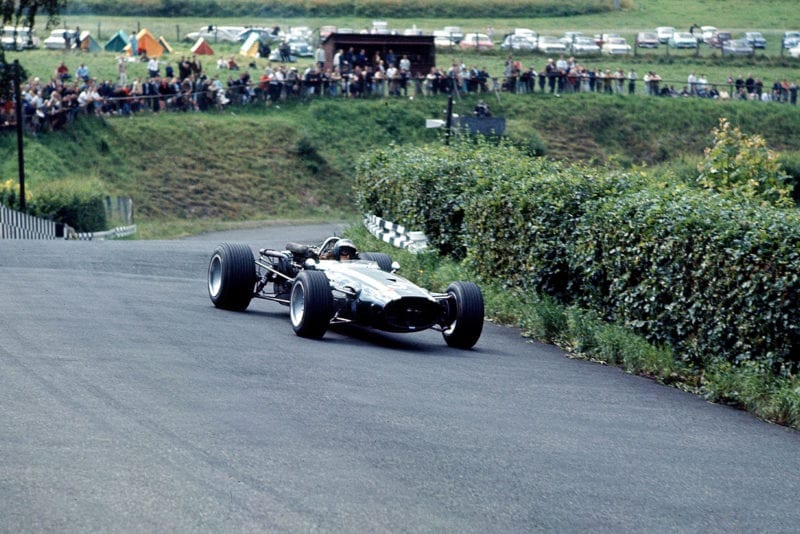
Rindt only completed four of the required five qualifying laps, leaving his starting place in jeopardy
Motorsport Images
Meanwhile others were in trouble, for Rindt had stopped out on the circuit when the flywheel of the spare Cooper-Maserati had come apart, smashing the crankcase, destroying the starter and cutting a great gash in the chassis. He had only completed four laps, but as he could not be found anywhere, having abandoned his damaged car, he was officially posted as a non-starter.
“As Rindt could not be found anywhere, having abandoned his damaged car, he was officially posted as a non-starter”
Spence had run into more mechanical trouble, this time with a broken crown-wheel and pinion and Amon had stopped out on the circuit with a faulty fuel pump on the newer Ferrari; Spence’s numbers were put onto the spare BRM and he was able to continue practice.
Trouble and ravaging by the Nürburgring was not confined to the works teams for Ligier had only done two slow laps on Friday as his Repco V8 would not run properly. After a lot of time had been wasted it was discovered that his mechanic had set the ignition timing to the wrong mark on the flywheel; no-one had told them when they bought the car that there were two timing marks on the flywheel and that one was no longer valid!
Practice finished at 1pm and the afternoon was taken up by the Formula Vee circus and some national touring car races so that Ferrari, Cooper and Lotus could not retrieve their abandoned cats until after 6pm, a gross piece of mismanagement on the part of the Automobile Club von Deutschland, which caused a lot of shouting and yelling in various languages.
This delay meant a lot of non-stop work to get the cars ready for the race. When it was realised officially that Rindt had not done his qualifying laps the rule was waived and he was re-instated on the starting grid. As the Formula Two cars were having a race of their own they were to have a starting grid of their own, behind the Grand Prix cars. They were to be one short as Redman had been forced to return home for domestic reasons; and a replacement driver could not be found for the maroon Lola.
Race
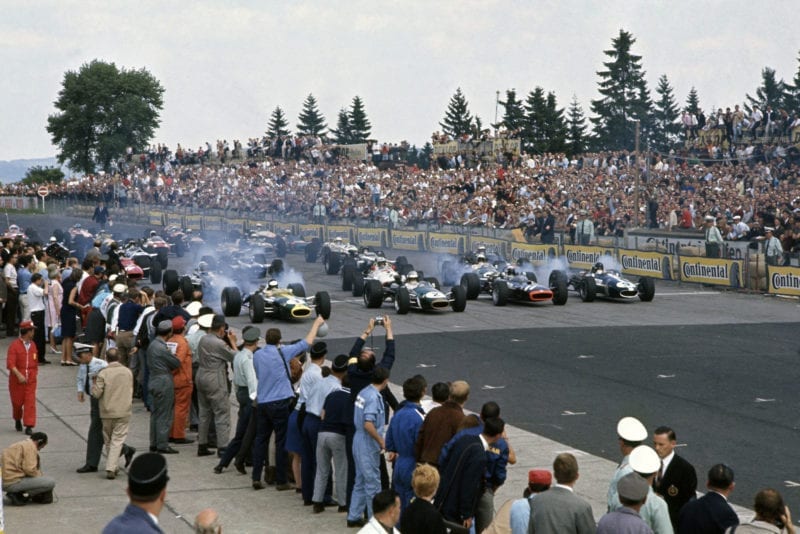
Tyre smoke abound as the cars leave the grid
Motorsport Images
The 15-lap Grand Prix was due to start at 2pm on Sunday and in bright sunshine the cars game up through the tunnel from the Paddock and were allowed a few minutes’ warming-up time around the short “pit circuit”.
Brabham’s BT24 car was all screwed together again, and the wear and tear on the chassis frame had been patched up. Hulme was all set to go, with second place on the grid. Clark was in 49/2 still with the thin unventilated discs as they had proved to be better, Hill was back in 49/1, the gearbox haying the very latest magnesium side-plates replacing the temporary cast-iron ones, Rindt was in the lightweight Cooper with 36-valve Maserati engine and running on the fabricated alloy disc wheels, while Rodriguez was in his usual 1966 car, with Cooper disc front wheels and McLaren cast-magnesium rear wheels.
The Honda was as used in practice and Amon was in the lightened Ferrari V12, with the new gearbox, the Zirconium alloy engine and a total in weight saving of more than 130lb. Gurney and McLaren were in the Eagles as practised and Stewart was in the latest BRM, Spence in 8302 and Irwin in 8301, all with 16-cylinder engines. The front row of the grid was outstanding for it comprised four cars, all very different in conception, Lotus 49, Brabham-Repco, BRM H16 and Eagle-Weslake, illustrating that there is little sign of any team getting a monopoly, which must provide Spectator appeal and satisfy organisers.
The seventeen Grand Prix cars and the eight Formula Two cars were lined up on a ” dummy grid ” and then moved forward for the starting signal. When the German flag fell Clark and Hulme accelerated away wheel to wheel for the first few yards and then the 400bhp of the Cosworth engine took hold and Clark was away into the lead.
As the field streamed down to the South Curve poor Graham Hill was elbowed on to the grass by lesser drivers who were with him on the back of the grid and with wheels on the grass it was not surprising that he locked a brake and spun. By sheer luck he did not collide with anyone and carried on right at the back now.
It was Clark who led away from the South Curve, with Hulme, McLaren and Gurney in hot pursuit and with a standing lap in 8min 22.5sec he completed the first lap with a 1½sec lead over Hulme, Gurney, Brabham, McLaren, Surtees, Stewart and Amon.
Needless to say Ickx was leading the Formula Two section and was already ahead of Hahne, Siffert, Bonnier, Hill, Ligier and Irwin who were in bigger engined cars. Even on this opening lap trouble began and Mitter retired while Hobbs stopped at the pits with a misfiring BMW engine, but there was also trouble at the front of the race for unbeknown to him Clark had a puncture in his right tear tyre and it was slowly losing pressure.
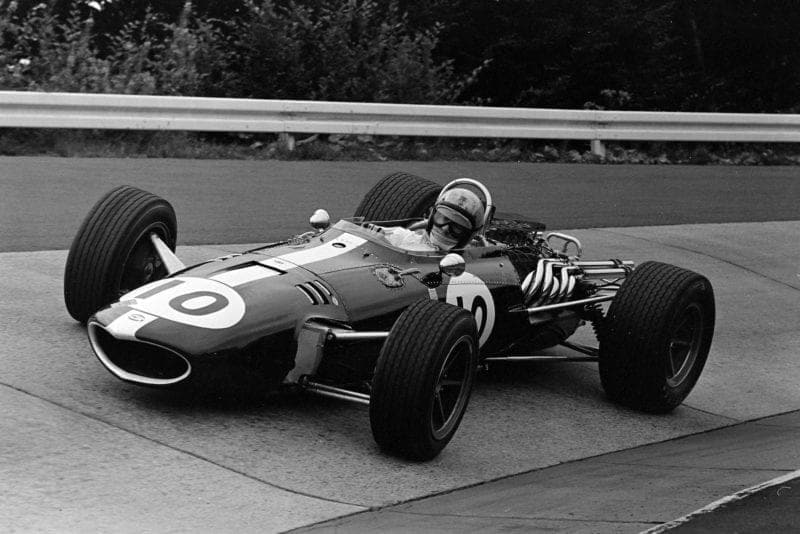
McLaren was making early progress in the AAR Eagle until mechanical gremlins struck
Motorsport Images
What he did know was that the Lotus felt unstable on the corners and he was having his work cut-out to keep it going where he wanted it to go. Thinking that it might be caused by having a full load of petrol and new tyres, a condition he had been unable to practise with, he tempered his pace to stay just ahead of Hulme and Gurney, making no attempt to drive on the limit and out-pace them, which is why the second lap was completed with the Lotus, the Brabham and the Eagle nose-to-tail, but the three of them well ahead of the rest of the runners.
McLaren had got past Brabham into fourth place and both Stewart and Amon had overtaken the Honda, while young Ickx was catching the Japanese machine, having overtaken Rindt, Spence and Rodriguez.
“Clark was still leading, but the Lotus was getting more and more difficult and he knew that something was wrong”
The pits were still busy for Siffert stopped with a sticking throttle pedal and a split water pipe, and Irwin came into the pits with a punctured left rear tyre on the Parnell BRM 16-cylinder car. Another wheel was fitted and he was back in the race, but there had been a moment of panic when he pressed the starter button and nothing happened, the exposed Bendix having stuck. A mechanic gave it a shrewd blow with the jack handle which freed it and the engine burst into life.
Meanwhile Clark was still leading, but the Lotus was getting more and more difficult and he knew that something was wrong so that although he kept ahead of Hulme and Gurney he finished lap three practically out of the cockpit trying to see what was wrong with the right rear corner of the Lotus.
The big fat Firestone tyre looked alright because the pressure was leaking out slowly and it was retaining its shape, but it was soft in comparison with the left rear tyre, which made the car very unstable, especially on left-hand corners.
This enforced slowing of the pace of the leaders allowed lckx to record a fastest lap in 8min 21.8sec, and on the fourth lap Clark could no longer cope with the peculiar handling of the Lotus and had to ease right off and let Hulme and Gurney go by, whereupon Gurney took his opportunity and got by Hulme and into the lead.
This was not the only trouble in the race, for Spence had pulled into the pits at the end of lap three with a broken crown-wheel and pinion in his BRM and the car was pushed to the dead-car park at the end of the pits, and Hobbs was back again with an unhappy BMW engine, while Schlesser stopped before the climb up to the Karussel with the centre torn out of his clutch.
From the cheers that sounded when Gurney took the lead with the Eagle, there were a lot of Americans among the spectators, but cheers turned to groans when it was announced that McLaren had stopped out on the circuit with the second Eagle amid a dense cloud of smoke and oil. The car had been grounding badly and had rubbed away the oil scavenge pipe under the sump.
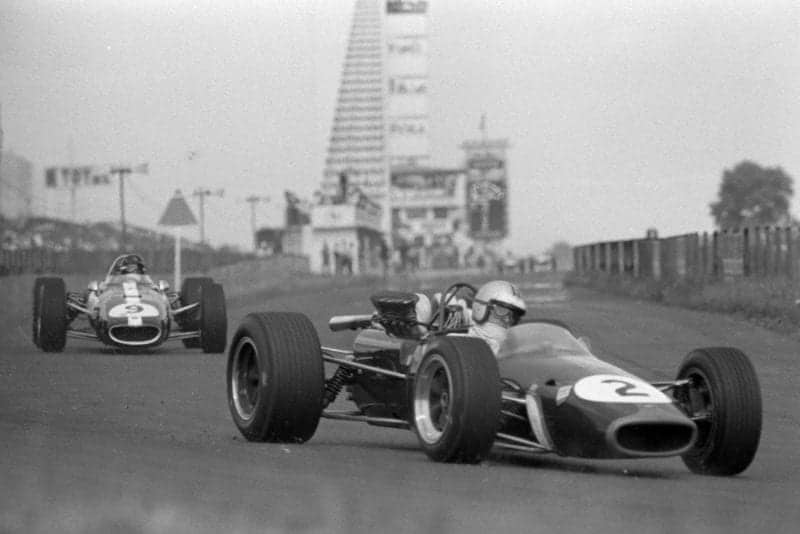
Hulme leads Gurney, but not for long
Motorsport Images
While Gurney led Hulme to complete the fourth lap, Clark drove slowly along wondering what could have gone wrong with the Lotus and most of the other competitors overtook him. As he rounded the Karussel he saw that his right front wheel was leaning in at a strange angle so he limped back to the pits.
At the end of only four laps the order was Gurney (Eagle), Hulme (Brabham), Brabham (Brabham), Stewart (BRM), lckx (Matra F2) the inconsiderate young Formula Two driver showing no respect for his elders and betters, passing Amon and Surtees, driving 3-litre Ferrari and 3-litre Honda, respectively. Perhaps Ickx only considers them elders!
Eventually Clark arrived at the pits with his right front wheel leaning inwards and it was seen that the inner portion of the suspension rocker arm was badly bent, as though the coil-spring/shock-absorber unit had been bottoming before the full wheel travel had been absorbed and the shock forces had buckled the rocker arm. The car was wheeled away to the paddock where Duckworth sniffed around it and found the right rear tyre with only to 10lbs/sq in pressure in it, and the Firestone chaps found a hole in the cover caused by a sharp object picked up off the track.
Having got the lead Gurney opened up and set a new lap record in 8min 18.2sec and by the end of lap five he had pulled out an eight second lead over Hulme’s Brabham-Repco V8.
It seemed now that the Nürburgring was going to relent and let the race take shape, for no-one visited the pits as the fifth lap was completed, the order behind Gurney and Hulme being Stewart, Brabham, Ickx, Amon, Surtees, Rodriguez, Hahne, Hill, Oliver, Rees, Ligier, Hart, Irwin and Hobbs, but Rindt was missing, his steering rack and pinion having come adrift.
“The carnage continued on the sixth lap for Stewart had his crown-wheel and pinion break and Hill and Rodriguez were both long overdue”
The carnage continued on the sixth lap for Stewart had his crown-wheel and pinion break and Hill and Rodriguez were both long overdue. Hill had been having a miserable time since his opening lap spin and had not been making any real impression on any of the other cars. As he was taking the very fast downhill left-hand sweep after the Flugplatz the Lotus had become very wayward at the front and had very nearly gone off the road. Hill slowed right down and saw that the right front wheel was wobbling badly, so he toured along for the rest of the lap and came into the pits. The trouble was that the wheel nut had come loose (or had not been tightened properly to begin with), so after mechanics had tightened it and checked the other front one, a not-very-confident Graham Hill rejoined the race.
Rodriguez arrived at the pits with his right rear wheel leaning drunkenly as a suspension ball joint had broken on the threaded neck. No other damage had been done so another one was fitted and the Mexican was able to continue.
Gurney was in fine form out in front of the race, increasing his lead over Hulme to 15 seconds, and it was not that Hulme was relaxing, for the Eagle completed its sixth lap in 8min 15.1sec, another lap record. This did convince Hulme that he was not going to keep up with Gurney, so he now eased back a bit as Brabham was in third place hut a long way behind.
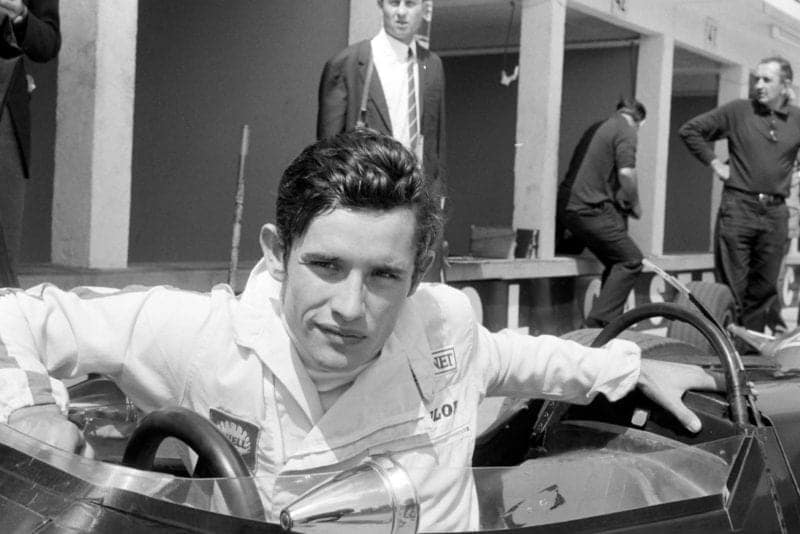
Young gun Ickx impressed on his debut
Motorsport Images
However, Brabham was being embarrassed by Ickx, who was right on his tail and looking completely confident, in fourth place overall. The rest of the field were spread out and going at various degrees of slowness, while the works BMW entry broke the front suspension of its Lola chassis.
Graham Hill thought all his troubles must be over, but he was wrong, for on the eighth lap the Allen screw that holds the top left suspension structure to the left cylinder head of the Cosworth engine, came unscrewed and the whole thing collapsed, unlike at Silverstone where just the transverse link came adrift. This should not be taken as a condemnation of the use of Allen screws, but the difficulty of locking these round headed screws, or guaranteeing that an over-worked mechanic has tightened it up properly. The unhappy Hill got the car back to the pits and it was quietly taken away, Team Lotus wondering if they should have changed their name to Team Shambles, as was suggested some years ago.
For a change the Anglo-American Racers were having things going their way, and the President of the Corporation was doing a fine job, lapping with ease and consistency, with Hulme dropping further back all the time, the gap being 42 seconds at 10 laps. Amon had decided that he had been behind the Matra Formula Two car long enough, and as the Ferrari was going better with less fuel load and part-worn tyres, he got it in between Brabham and Ickx and began to press the wily old Australian, as he had done at Silverstone.
Irwin came into the pits with a broken clutch and parts were taken off Spence’s abandoned car to effect a repair. While this was going on some petrol was put in the tanks as the consumption was a bit heavy, and Tim Parnell was fined 200 deutschmarks for infringement of rules. A new ruling forbidding refuelling during a race has crept into one or two Grand Prix races recently without anyone being told very clearly.
The race situation remained unchanged on lap 11, with Gurney now 46 seconds ahead and relatively coasting along to victory, having convinced Hulme that the Brabham-Repco V8 was no match for the Eagle-Weslake V12.
A long way back came Brabham, Amon and Ickx in close company, followed by Surtees in a very poor sixth place, the Honda giving a very bad exhibition and behind came Oliver (Lotus F2), Bonnier and Rees (Brabham F2), the remainder having been lapped by Gurney.
On lap 12 Ickx was no longer behind the Ferrari for the right front lower ball-joint had broken on the threaded shank and let the suspension collapse, though the car could still be driven back to the pits, where it was retired, much to the relief of a number of Grand Prix drivers.
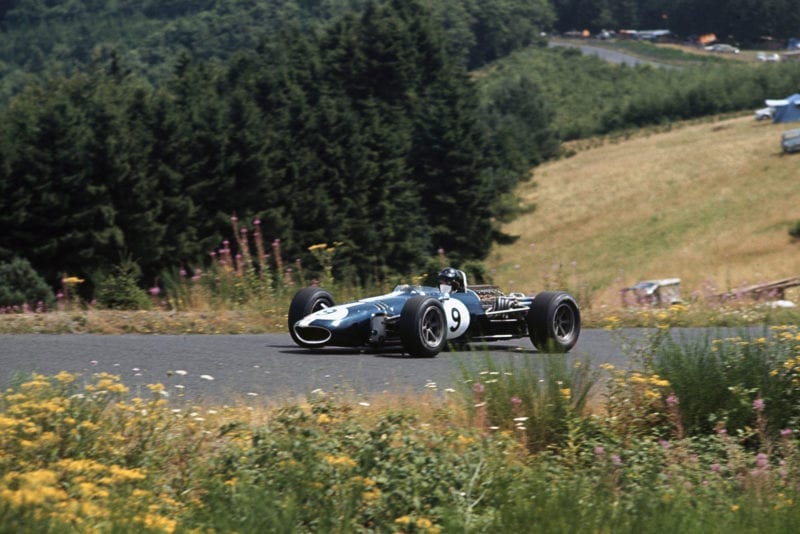
Gurney was sitting pretty for the win until his car failed once again
Motorsport Images
It seemed that nothing could stop Gurney from victory for the Weslake engine was running beautifully, the Eagle was handling well and there was no need to strain anything or for the driver to try too hard, but two-thirds of the way round the thirteenth lap the wicked Gods of the Nürburgring struck again and a universal joint on a drive shaft broke, the flailing broken shaft cutting through an oil pipe.
A miserable and unhappy Gurney coasted the Eagle on to the side of the track, just before the climb up to the Karussel, not far from where Schlesser had stopped earlier, and sat and watched Hulme drive on to victory, stamina and sheer reliability reaping its reward.
“Two-thirds of the way round the thirteenth lap the wicked Gods of the Nürburgring struck again and a universal joint on Gurney’s drive shaft broke”
For the remaining laps Amon tried desperately to get by Brabham, whose car always seemed to be filling all the available road and to get wider the closer the Ferrari got to the back tyres. Had Amon known the fuss that team-manager Franco Lini was having in the pits, crying out for revenge and cursing the whole Brabham Racing Organisation, and imploring the organisers to disqualify Brabham for being beastly and not letting Amon go by, he would have been greatly encouraged.
The Brabham pit personnel just grinned and said “It’s motor racing mate, an’ our bloke’s in front”. Not only was their ” bloke ” in front of the Ferrari, but their other “bloke” was way out in front of the race and heading for his second Grand Prix victory this season.
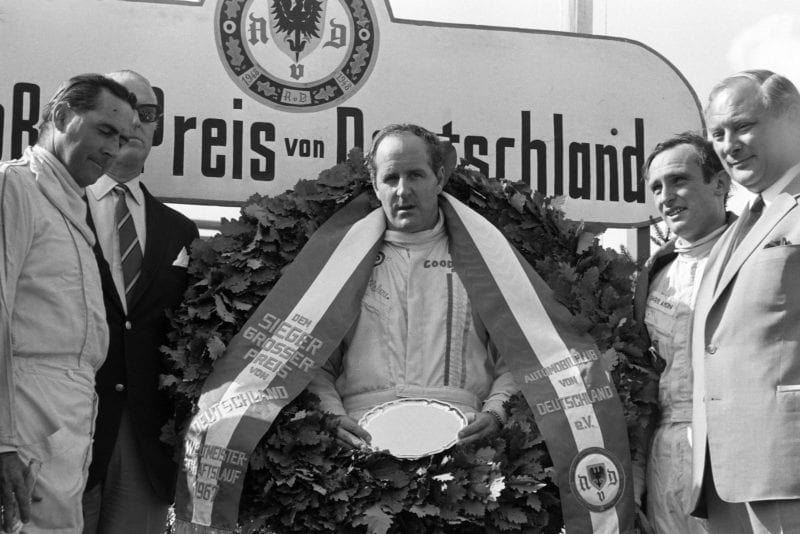
Gurney celebrates his win
Motorsport Images
Even the most anti-Brabham racegoer (and there are those who are for and those who are against all the various teams) had to admit that the Australians build rugged and reliable cars, even if they are not very sophisticated, and the rugged and reliable driving ability of Hulme and Brabham makes up for a big lack of horsepower.
There was nothing that Amon could do but finish third, half a second behind Brabham, who grinned happily to see his team-mate getting the winner’s laurels, while Surtees finished a very unworthy fourth in the rough-sounding Honda that seems to go from bad to worse.
The retirements of all the factory cars allowed Bonnier and Ligier to figure in the results and improve their status. It had been a punishing race with the Nürburgring coming out on top in many cases, though a lot of the breakages should never have happened, but most people seem unable to weigh up the real challenge that the Eifel circuit puts out.
Nürburgring natterings
- Officially it was estimated that there were 260,000 people around the 14 mile circuit. Even if this was 50% optimistic it still left a crowd of 130,000 and there were certainly a lot of people and cars about.
- Strange that the winner of the German GP is not a member of the ‘Grand Prix Drivers’ Association. He says he doesn’t want to join “Bonnier and his lot.” Grand Prix racing is alright as far as, he is concerned.
- Graham Hill considers he had a season’s incidents in one weekend, and felt that things can only get better, they can’t possibly get worse.
- The combination of Amon and Ferrari seem to have found their limit in the Brabham team, but it will no doubt be different on fast Monza circuit.
- Although Hulme was not at the limit he set up a new race average record of over 101mph for the 15 laps. Gurney took the lap record at more than 103mph.
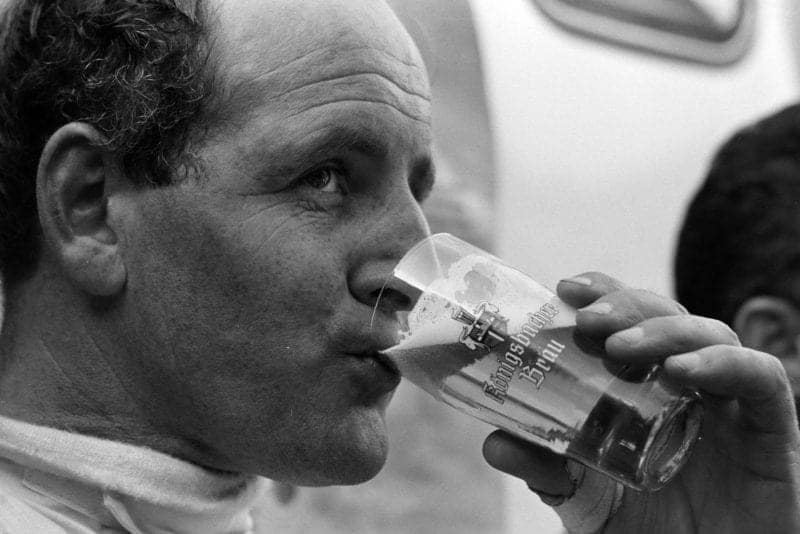
Hulme certainly earned his post-race beer
Motorsport Images
